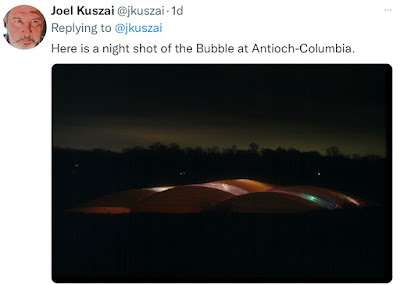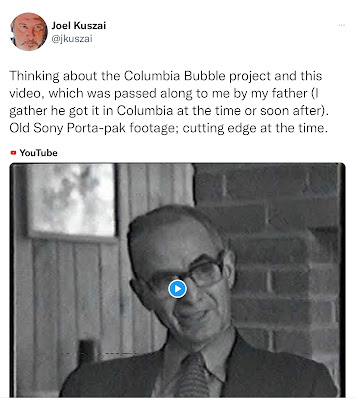It’s time. I’ve been sitting on this discovery since the end of August. Remember this?
It’s very likely that the Columbia Archives really is our Columbia Curiosity Bureau. I tend to think of it as the very respectable repository of significant documentation of the Great Columbia Experiment. And yet the archives probably contain a fair amount of the unusual, humorous, and surprising. A few weeks ago I stumbled on a bit of Columbia history that I had been completely ignorant of and it was the wackiest, most way-out thing I’ve learned about the place in 23 years. - - “In Defense of Curiousity”, 9/30/22
At last, the big reveal. Today: what I learned. Tomorrow: ideas and commentary. It just won’t fit into one post. Besides, it will help take my mind off of the election.
It all began as I was scrolling Twitter searching the words “Columbia, Maryland”.
“…Antioch College’s early 70s inflatable structure at its satellite campus at Columbia, Maryland.”
Wait, what?
- There was post-secondary education in Columbia before Howard Community College?
- Inflatable?
I was wowed. I found myself in an Alice in Wonderland adventure, where each new revelation was curiouser and curiouser.
“Here is a night shot of The Bubble at Antioch-Columbia.” The Bubble? I’ve lived here for over twenty years. I know about the ColumBus, the old Columbia Visitor Center, that the library used to be in the Wilde Lake Village Center and how the Longfellow 4th of July parade started. Nobody, but nobody has ever talked about The Bubble. Honestly, I would remember that.
I imagined calling up Barbara Kellner, founder and former director of The Columbia Archives. “Why did you never tell me about The Bubble?” But I knew what she would say. “Well, you never asked.”
It so happens that there’s a Facebook page devoted to the Antioch satellite campuses in Baltimore and
Columbia. They were in existence from 1969 to 1981. Twelve short years.
As I’ve probably mentioned, I grew up in Ohio. Antioch is an Ohio school, pioneers in experiential learning and cooperative education. My older sisters had friends who went to Antioch. Our family belonged to the Unitarian Society of Cleveland which leaned extremely liberal for the time, especially the youth group that my sisters participated in: LRY, which stood for Liberated Religious Youth. Antioch was exactly the kind of place that would have appealed to these late-sixties young people.
But I never had any inkling that there was an Antioch in Columbia.
Photo credit: Baltimore Sun
“1970 photo of Morris Keeton (left), academic Vice President of Antioch-Columbia, in from of Oakland Manor with staff members Mike Metty (center) and Peter Gerber” You can read the article “Visionaries: Mike Metty” in the
Antioch Alumni Magazine. The author is Geoffrey Himes '72, '75 (Antioch Maryland, BA, MA)
In the early-1960s, the real estate developer Jim Rouse began quietly buying up parcels of land in Maryland’s Howard County, a mostly rural area strategically located between Baltimore and Washington. Once he had assembled a critical mass of properties, Rouse announced that he was going to create a planned city he called Columbia. Among his many plans for the new town was an experimental school, and so he reached out to Ohio’s Antioch College, because, says Metty, “he admired the liberal work/study perspective they brought to higher ed.”
Most of us know the facts at the beginning of that paragraph. The Columbia origin story is deeply engrained in me even though I didn’t arrive until 1999. But the part that Rouse wanted to establish an experimental school? That was news to me.
Metty arrived in Maryland as a tall, rail-thin 27-year-old, with a hint of whiskers on his chin. He was confronted by a planned city that was still more plan than city. Columbia had some man-made lakes, a summer home for the Baltimore Symphony Orchestra, a Frank Gehry-designed Rouse Company Building and a few scattered housing clusters and village centers. But most of the town was still woods and muddy fields where the planned mall, office buildings and housing were meant to go. Metty, Keeton, fellow Syracuse transplant Steve Plumer and Yellow Springs refugee Judson Jerome set up offices in the Columbia Manor, a pre-Rouse mansion on a hill, to hire faculty and staff and to recruit students.
But what about The Bubble? From the article:
The “Antioch bubble” was an inflatable vinyl structure created to house the entire Columbia campus. Students even helped design the facility as part of their environmental design curriculum. Plans for the 30,000 square-foot campus – including classrooms, offices, and indoor gardens – were approved in May 1972, and the bubble was inflated in November of that year by students and faculty. A June 1973 New York Times story, “Plastic Bubble, New Dimension in U.S. Education,” praised the structure as “gaining popularity as a deliberately impermanent and highly flexible means of providing shelter for higher education.” But by October 1973, there were major “bubble troubles,” including heating and cooling problems, weather issues, and vandalism. Around Thanksgiving 1973, a strong wind collapsed the bubble, and thieves stole everything from toilets to control panels. The bubble was put up for sale at a loss, and that was the end of the country’s first inflatable campus.

Photo from Himes article, Mike Metty:Visionaries, Antioch Alumni Magazine
“Plastic Bubble, New Dimension in U.S. Education” Evan Jenkins, The New York Times, 1973
Oh, how fleeting. For one brief year Columbia had a Bubble. The students actually put it up themselves. There exists film footage of this process but I foolishly didn’t copy the link and now the person who originally inspired this post, Joel Kuszai, has departed from Twitter. Back in August I did not forsee the possibility of Twitter blowing away and being plundered like the Antioch Bubble. My apologies.
Wait. Mr. Kuszai left a breadcrumb trail for us. Twitter may be imploding but YouTube is still going strong.
It’s almost an hour long. You probably won’t want to sit through the entire thing. I’ll admit I didn’t and I’ve just now discovered there’s footage of Rouse talking about the project. I know how I’ll be spending my afternoon.
It begins with a description of the logistical challenges in creating and using a space like the Bubble. This part is very much the white executive guy in a suit, smoking his cigarette and being The Grownup. That’s Harold B. Gores of Educational Facilities Laboratories. But after that you’ll see the students themselves. Watch a bit of that before you switch it off.
Sample image from “The Trials of Antioch East”, by Ellen Hoffman, Change: The Magazine of Higher Learning, 1971
“…the campus became an experimenting one, not experimental.”
What a breathtaking ride this took me on that late summer evening when I honestly was looking for local back-to-school posts. And I’m still not done learning or thinking about it.
Come back tomorrow for ideas and commentary. I won’t be disappointed if you already knew about this dazzling era in Columbia’s early history. In fact, maybe you can tell me things I haven’t learned yet.
This is definitely one for the Columbia Curiousity Bureau.











Comments
Post a Comment